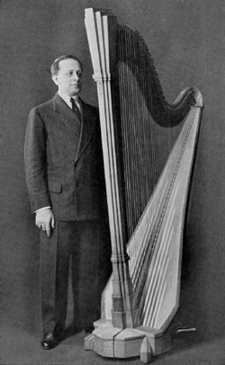 Carlos
Salzedo was born Charles Moise Léon Salzedo on
April 6, 1885. Salzedo's parents, Isaac Gaston Salzedo was a
singer and his mother Thérèse Judith Anna Silva,
a pianist. Salzedo's mother died when he was just five. The family
then moved to Bordeaux where Leon (Carlos) began playing piano
at the age of three, and wrote his first composition, a polka
called Moustique, which was published, at the age of five. At
six, he entered the St. Cecilia School of Music, where he won
first prize in piano and solfège three years later, after
which the family moved to Paris. Carlos entered the Paris Conservatoire
at nine years old, where he again won prizes in piano (Descontes)and
solfège (Schwartz). He continued his piano studies with
Charles de Beriot, son of a renowned violinist and a piano pupil
of Thalberg. Carlos
Salzedo was born Charles Moise Léon Salzedo on
April 6, 1885. Salzedo's parents, Isaac Gaston Salzedo was a
singer and his mother Thérèse Judith Anna Silva,
a pianist. Salzedo's mother died when he was just five. The family
then moved to Bordeaux where Leon (Carlos) began playing piano
at the age of three, and wrote his first composition, a polka
called Moustique, which was published, at the age of five. At
six, he entered the St. Cecilia School of Music, where he won
first prize in piano and solfège three years later, after
which the family moved to Paris. Carlos entered the Paris Conservatoire
at nine years old, where he again won prizes in piano (Descontes)and
solfège (Schwartz). He continued his piano studies with
Charles de Beriot, son of a renowned violinist and a piano pupil
of Thalberg.
Salzedo's father, by then a well-known voice teacher, decided Carlos
should take up a second instrument, and harp was chosen, because
he was too weak to play a wind instrument and his older brother Marcel
played violin. Beginners were not accepted at the Conservatoire,
so Carlos took lessons from Marguerite Achard. After a few months,
he had advanced enough that he was accepted as a pupil by Alphonse
Hasselmans, professor of harp at the Conservatoire. After a year
of study with Hasselmans, he entered the Conservatoire as a fully-fledged
harp pupil at the age of thirteen. In 1901, at age sixteen, Salzedo
won the premier prix in harp and piano on the same day,
a feat unmatched before and since, and was awarded a Steinway grand
piano. Salzedo also studied composition while at the Conservatoire,
ultimately winning great praise from the director, Gabriel Fauré.
In 1909, Arturo Toscanini invited Salzedo to play for the Metropolitan
Opera in New York, and Carlos left France for America, without knowing
any English. Salzedo was introduced at a soiree to Viola Gramm, a
respected pianist and singer. She had studied in Paris. She became
romantically involved with Salzedo, and they were married in 1914
while in France. He became ill during the war and discharged from
the army and returned to the us in 1916. In the Twenties, Salzedo
and Mimine grew apart and divorced in 1926. in 1928, 42-year-old
Salzedo married 21-year-old Lucile Lawrence, who had begun her studies
with him ten years earlier and developed into a virtuosa in her own
right. Salzedo had a very extensive performing schedule in these
years, with tours by the Trio de Lutece, the Salzedo Harp Ensemble,
and solo appearances. Lawrence served as first harp of the Salzedo
Harp Ensemble, a high-profile group, and she also led her own Lawrence
Harp Quintette on engagements too small for the Salzedo Harp Ensemble.
Salzedo was involved in many arenas, including the burgeoning "new
music" circles in New York, where he co-founded the International
Composers Guild with Edgard Varèse.
Salzedo is well-considered history's great harpist. He was as highly
regarded as a pianist and conductor by his colleagues as he was by
harpists. He influenced many composers with his new ideas for the
harp's sounds and notation. His artistic ideas led to the designs
of two harps still manufactured by Lyon & Healy, the art-nouveau
style 11 and the art deco Salzedo model, which was designed by his
friend, the artist Witold Gordon. The Salzedo model harp is based
on the number 5, his favorite number, and has five stripes of each
color on the sounding board fashioned the art deco style.
He founded the harp program at the Institute of Musical Art in New
York City (now the Juilliard School), at the Curtis Institute of
Music in Philadelphia, and at the Salzedo Harp Colony in Camden,
Maine with Lucile Lawrence. Salzedo's students numbered in the hundreds.
Many currently perform in symphony orchestras across the US as well
as teaching positions at conservatories and universities. Salzedo
is often labeled as the Father of the modern harp technique and composition.
He died on August 17, 1961, in Waterville, Maine, at the age of 76.
christophershayne.com |
